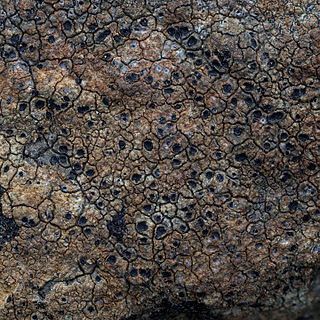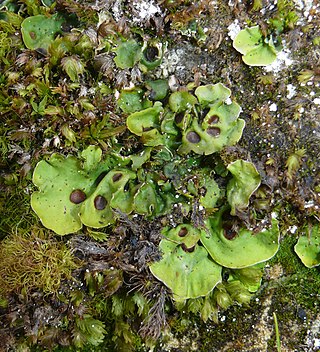
Agaricus bisporus, commonly known as the cultivated mushroom, is an edible basidiomycete mushroom native to grasslands in Eurasia and North America. It has two color states while immature – white and brown – both of which have various names, with additional names for the mature state.

Panaeolus is a genus of small, black-spored, saprotrophic agarics. The word Panaeolus is Greek for "all variegated", alluding to the spotted gills of the mushrooms produced.

Copelandia is a now deprecated genus of mushrooms consisting of at least 12 species. Many American mycologists previously placed members of Panaeolus which stain blue into Copelandia, whilst European mycologists generally used the name Panaeolus instead. Now all mushrooms previously categorised under Copelandia are universally classified in Panaeolus. The genus Copelandia was created as a subgenus of Panaeolus by Abbé Giacomo Bresadola (1847–1929) in honor of Edwin Bingham Copeland (1873–1964), an American who gathered fungi in the Philippines and sent some collections to Bresadola.

Mycoaciella is a genus of corticioid fungi in the family Meruliaceae. The genus was circumscribed by John Eriksson and Leif Ryvarden in 1978. After microscopic examination of the three species then in the genus, Karen Nakasone proposed to synonymize Mycoaciella with Phlebia.

Dendrothele is a genus of fungi in the family Corticiaceae. According to a 2008 estimate, the genus has 36 widely distributed species.

Ingvariella is a lichen genus in the family Stictidaceae. Circumscribed in 1997, the genus is monotypic, containing the single widespread lichen species Ingvariella bispora. The species was originally named Urceolaria bispora by Italian lichenologist Francesco Baglietto in 1871. Ingvariella is named in honour of Swedish lichenologist Ingvar Kärnefelt.
Rechingeriella is a genus of fungi in the family Zopfiaceae; according to the 2007 Outline of Ascomycota, the placement in this family is uncertain.

Oudemansiella is a genus of fungi in the family Physalacriaceae. The genus contains about 15 species that are widely distributed in tropical and temperate regions. Yang and colleagues revised the genus in a 2009 publication, describing several new species and several varieties. They classified species in the genus into four sections based on the structure of the cap cuticle: Oudemansiella, Mucidula, Dactylosporina, and Radicatae.

Galeropsis is a genus of fungi in the Bolbitiaceae family of mushrooms. The genus is widespread in dry, arid habitats, and contains 16 species. Galeropsis was circumscribed by the Czech botanist Josef Velenovský in 1930.
Rhytidospora is a genus of fungi within the family Ceratostomataceae.

Trechispora is a genus of fungi in the family Hydnodontaceae. Basidiocarps are variously corticioid or clavarioid with spore-bearing surfaces that are variously smooth to hydnoid or poroid. The genus occurs worldwide, though individual species may be localized. Around 50 species have been described to date.
Neocampanella is a genus of fungus in the family Marasmiaceae. The genus is monotypic, containing the single species Neocampanella blastanos.

Solorina is a genus of 10 species of lichenized fungi in the family Peltigeraceae. The genus was first described by the Swedish botanist Erik Acharius in 1808. Members of the genus are commonly called socket lichens.

Brunneocorticium is a genus of fungi which following DNA analysis has been placed in the family Omphalotaceae. The genus, described in 2007, contains two corticioid species and one species which does not seem to have any fruiting body.
Athelopsis is a genus of corticioid fungi in the family Amylocorticiaceae. The widespread genus, estimated to contain 10 species, is polyphyletic as currently circumscribed.

Rossbeevera is a genus of sequestrate (truffle-like) fungi in the family Boletaceae. It was first published in 2012 under the erroneous name Rosbeeva, but was corrected to Rossbeevera in the same issue. The genus was created to contain species formerly placed in Chamonixia, but characterized by having ellipsoid to spindle-shaped spores with 3–5 longitudinal ridges, bluish-green to deep blue fruit body staining reaction, and a thin whitish peridium. The Chinese species R. yunnanensis is the earliest diverging lineage within the genus, and has a close phylogenetic relationship with the bolete genera Turmalinea and Leccinellum.

Badhamia is a genus of slime molds in the family Physaraceae. It was circumscribed by English naturalist Miles Joseph Berkeley in 1853. The widespread genus contains about 30 species.

Hymenopellis is a genus of fungi in the family Physalacriaceae. The genus was described by mycologist Ron Petersen in 2010. The type species is Hymenopellis radicata, originally described by British botanist Richard Relhan in 1780 as Agaricus radicatus.
Intralichen is a genus of lichenicolous fungi of uncertain classification in the class Ascomycota. It has four species. The genus was circumscribed by David Leslie Hawksworth and Mariette S. Cole in 2002, with Intralichen christiansenii as the type species.
Swinscowia bispora is a species of corticolous (bark-dwelling) lichen in the family Strigulaceae. Found in Korea, it was formally described as a new species in 2014 by lichenologists André Aptroot and Kwang-Hee Moon as a member of genus Strigula. The type specimen was collected from Mount Juwang at an altitude between 320 and 380 m ; there, it was found growing on the bark on an oak tree. The taxon was transferred to the genus Swinscowia in 2020 following a molecular phylogenetics-led reorganisation of families and genera in the order Dothideomycetes. The species epithet bispora rfers to the fact that each ascus contain two ascospores. The ellipsoid-shaped spores measure 117–135 by 38–48 μm; they are densely muriform, meaning they are divided into multiple chambers by both transverse and longitudinal septa.














